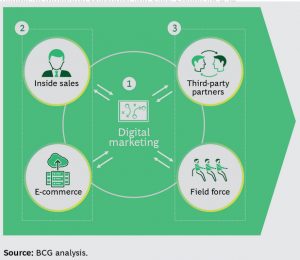Digital and mobile technologies are reshaping the B2B marketplace. This isn’t only a technological revolution, it’s also a paradigm shift in how B2B buyers consume content, make informed buying decisions, and engage with salespeople.
Today’s buyer is empowered by the internet and no longer relies on sales as a primary source of information, especially early in the purchase journey. More often than not, this journey starts online in the domain of marketing. It may end up offline in sales or as an e-commerce transaction; either way, customers expect a seamless, highly personalized buying experience from start to finish. This makes marketing and sales alignment more important than ever. Achieving this alignment, though, can be complex, and success often requires overcoming significant cultural barriers and the complete transformation of the marketing and sales model.
Our work with many B2B market leaders, as well as recent interviews with more than 50 senior marketing and sales executives at top technology and industrial companies, has made it clear that B2B companies need to transform the way they engage customers, use data and technology, structure their organizations, and acquire new skills. Companies that get it right can drive impressive results, including, in our experience, 15% to 30% improvement in marketing efficiencies (such as reduced cost per lead), 20% to 50% increases in digital ROI, and a two- to threefold improvement in marketing-driven lead conversion across the entire purchase journey. In one case, a leading global software player was able to double marketing-attributable revenue for its cloud business while reducing cost per lead by 30%. As with many types of fundamental corporate change, early movers can establish a lead over the competition that will make it hard for others to catch up.
The Evolving Marketing and Sales Functions
As we have written before, there’s a new B2B buyer out there. She is younger, digitally engaged, and doing more and more business online and on a smartphone. (See “How Digital Leaders Are Transforming B2B Marketing,” BCG article, April 2017, and “Mobile Marketing and the New B2B Buyer,” BCG article, September 2017.) The new buyer’s experiences and expectations are shaped by B2C leaders such as Apple, Amazon, and Netflix. She looks for the same type of online experience in the workplace.
Today’s B2B buyers do things differently than their predecessors—all the way through the purchase process. Understanding their changing behavior, particularly in their use of online and mobile channels, is the critical starting point for B2B companies. In this new paradigm, buyers are much further down the path of making a decision before they engage with a sales rep. Recent research from Google suggests that the average B2B buyer is two-thirds of the way through the journey before talking to sales. Companies that do not engage customers effectively online are at risk of losing opportunities before they are even aware they exist. Historically, the marketing function has focused on the early stages of lead generation, then handed off leads quickly to sales.
More: https://www.bcg.com/publications/2018/
By Phillip Andersen , Robert Archacki , Basir Mustaghni , and Roger Premo
